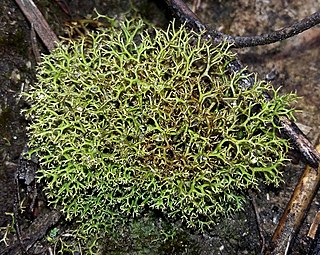Myelorrhiza is a genus of two Australian species of lichenized fungi in the family Ramalinaceae. It was circumscribed in 1986 by Australian lichenologists Doug Verdon and John A. Elix. Myelorrhiza was originally classified in the family Cladoniaceae until Kistenich and colleagues, using molecular phylogenetic analysis, showed that it is more appropriately placed with the Ramalinaceae.

Cladia is a genus of lichen-forming fungi in the family Cladoniaceae. Cladia species have a crustose or squamulose (scaly) primary thallus and a fruticose, secondary thallus, often referred to as pseudopodetium. The type species of the genus, Cladia aggregata, is widely distributed, occurring in South America, South Africa, Australasia and South-East Asia to southern Japan and India. Most of the other species are found in the Southern Hemisphere.
Physcidia is a genus of lichen-forming fungi in the family Ramalinaceae. The genus was circumscribed in 1862 by American lichenologist Edward Tuckerman.

Phyllopsora is a genus of lichen-forming fungi in the family Ramalinaceae. It was circumscribed by Swiss botanist Johannes Müller Argoviensis in 1894, with Phyllopsora breviuscula assigned as the type species.
Psoromidium is a genus of lichens in the family Pannariaceae. It has three species. The genus was circumscribed by Scottish naturalist James Stirton in 1877, with Psoromidium wellingtonii assigned as the type species.

Pannaria is a genus of lichen-forming fungi in the family Pannariaceae. The widespread genus contains an estimated 51 species, found primarily in tropical regions.

Degelia is a genus of lichen-forming fungi in the family Pannariaceae. The genus is named after Swedish lichenologist Gunnar Degelius.

Pyrrhospora is a genus of lichen-forming fungi in the family Lecanoraceae. The genus was circumscribed by German lichenologist Gustav Wilhelm Körber in 1855, with Pyrrhospora quernea assigned as the type species.

The Lecideaceae are a family of lichens in the order Lecideales.

Protoparmelia is a genus of lichenized fungi in the family Parmeliaceae. The genus has a widespread distribution, and contains 11 species. Protoparmelia was circumscribed by French lichenologist Maurice Choisy in 1929.
Megalaria is a genus of lichen-forming fungi in the family Ramalinaceae. The genus was circumscribed by Austrian lichenologist Josef Hafellner in 1984, with Megalaria grossa assigned as the type species.
Tasmidella is a lichen genus in the family Ramalinaceae. Circumscribed by Gintaras Kantvilas, Josef Hafellner, and John A. Elix in 1999, it contains the single species Tasmidella variabilis, found in Tasmania. It is distinguished from the closely related genus Megalaria by having simple spores with a layered wall.

Mycoblastus is a genus of crustose lichens in the family Tephromelataceae. Members of the genus are commonly called blood lichens.
James Stirton was a Scottish physician and one of Scotland's leading experts on cryptogamic botany. His investigations in bryology and lichenology earned him a world-wide reputation.

Bilimbia is a genus of lichen-forming fungi in the family Ramalinaceae.
Punctelia subalbicans is a species of foliose lichen in the family Parmeliaceae. It is found in Australia and New Zealand, where it grows on the bark of various tree species.

Loxospora is a genus of lichen-forming fungi in the family Sarrameanaceae. It has 13 species. The genus was circumscribed by Italian lichenologist Abramo Bartolommeo Massalongo in 1852, with Loxospora elatina assigned as the type species. This crustose lichen was originally named Lecanora elatina by Erik Acharius in 1810.

Yarrumia is a genus of lichen-forming fungi in the subfamily Lobarioideae of the family Peltigeraceae. It has two foliose species that are found in New Zealand. Lichen products that have been detected in the genus include polyporic acid, pigments and stictane triterpenoids. The genus was circumscribed in 2015 by David John Galloway. The generic name Yarrumia honours James Murray (1923–1961) "who first detected polyporic acid in the two species comprising the genus, and who contributed so much to New Zealand lichenology, subsequent to his initial interest in the chemistry of Yarrumia coronata dating from 1949".

Crocodia is a genus of foliose lichens in the family Peltigeraceae. It has eight species. The genus has a cosmopolitan distribution, although most species occur in temperate and tropical regions of the Southern Hemisphere. The main characteristics of the genus that separate it from its parent genus, Pseudocyphellaria, include a yellow medulla and yellow pseudocyphellae on the lower thallus surface.












